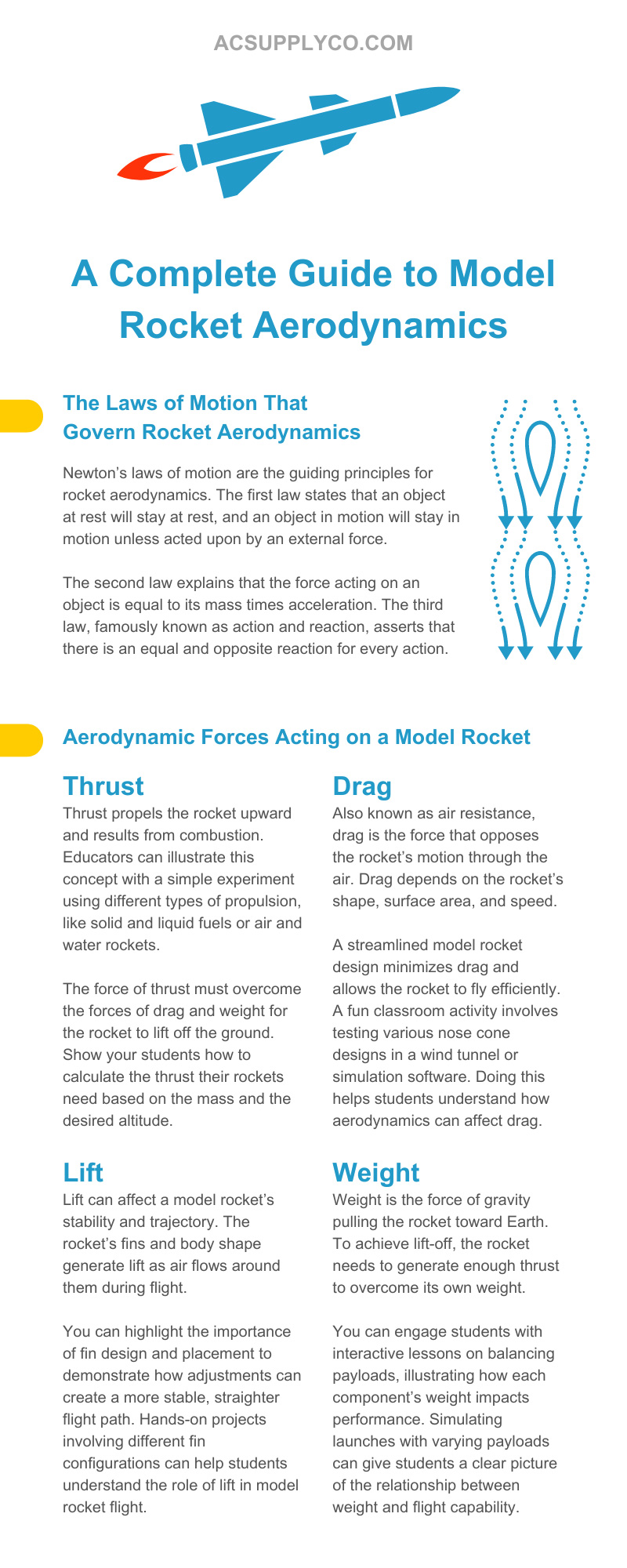Aspiring rocket engineers often start their journeys with model rockets. Your students can experience the joys of flight and reinforce their knowledge of scientific concepts through rocket science.
Understanding the principles of rocket aerodynamics is crucial for a successful launch. Our complete guide to model rocket aerodynamics offers insights and tips that will help your science lessons reach new heights.
What Are Rocket Aerodynamics?
Rocket aerodynamics is the study of how air interacts with rockets in motion. When launching a rocket, several forces impact the rocket’s flight path: thrust, drag, lift, and weight. Your students must balance these forces to achieve a smooth, stable flight.
Why You Should Teach Aerodynamics Before the First Launch
Before your students launch their model rockets, they need to understand aerodynamics. Poor aerodynamic design can result in instability, causing the rocket to veer off course and crash.
Understanding aerodynamics will allow your students to optimize their rockets’ shape, size, and flight path. They’ll have safer, more predictable, and more exciting launches as a result.
The Laws of Motion That Govern Rocket Aerodynamics
Newton’s laws of motion are the guiding principles for rocket aerodynamics. The first law states that an object at rest will stay at rest, and an object in motion will stay in motion unless acted upon by an external force.
The second law explains that the force acting on an object is equal to its mass times acceleration. The third law, famously known as action and reaction, asserts that there is an equal and opposite reaction for every action.
These fundamental principles are at the heart of how rockets rise from launch pads and soar through the sky. You should review these principles with your students before they begin building their model rockets.
Aerodynamic Forces Acting on a Model Rocket
Understanding the aerodynamic forces acting on a model rocket is key to engineering a successful and exciting launch. Your students will benefit greatly by delving into these fundamental forces. Let’s explore the four main forces that come into play: thrust, drag, lift, and weight.
1. Thrust
Thrust propels the rocket upward and results from combustion. Educators can illustrate this concept with a simple experiment using different types of propulsion, like solid and liquid fuels or air and water rockets.
The force of thrust must overcome the forces of drag and weight for the rocket to lift off the ground. Show your students how to calculate the thrust their rockets need based on the mass and the desired altitude.
2. Drag
Also known as air resistance, drag is the force that opposes the rocket’s motion through the air. Drag depends on the rocket’s shape, surface area, and speed.
A streamlined model rocket design minimizes drag and allows the rocket to fly efficiently. A fun classroom activity involves testing various nose cone designs in a wind tunnel or simulation software. Doing this helps students understand how aerodynamics can affect drag.
3. Lift
Lift can affect a model rocket’s stability and trajectory. The rocket’s fins and body shape generate lift as air flows around them during flight.
You can highlight the importance of fin design and placement to demonstrate how adjustments can create a more stable, straighter flight path. Hands-on projects involving different fin configurations can help students understand the role of lift in model rocket flight.
4. Weight
Weight is the force of gravity pulling the rocket toward Earth. To achieve lift-off, the rocket needs to generate enough thrust to overcome its own weight.
You can engage students with interactive lessons on balancing payloads, illustrating how each component’s weight impacts performance. Simulating launches with varying payloads can give students a clear picture of the relationship between weight and flight capability.
Tips for Determining the Drag Force
Determining the drag force involves understanding the rocket’s speed, surface area, and the air density it passes through. Air density changes with altitude and affects drag differently during various flight phases.
Instruct your students to use drag coefficients specific to their model rockets’ shape and perform wind tunnel tests to get accurate drag measurements. Your students can also use simulation software to analyze a model rocket’s performance and fine-tune its design for optimal lift-off.
The Importance of Aerodynamic Stability for Rocket Launches
Aerodynamic stability is paramount to a successful model rocket launch. Stability keeps a rocket flying in the intended direction without spiraling out of control. Your students can achieve stability by making careful design choices, such as thoughtfully placing the center of gravity and the center of pressure. Balancing these points helps the rocket remain stable throughout its flight.
How To Test the Stability of Your Model Rocket
Your students can test the stability of their model rockets in several ways. One common technique is the swing test, where your students tie the rocket to a string and swing it in a circular motion.
If the rocket points forward during the swing, it indicates good stability. Additionally, computer simulations and wind tunnel tests can provide detailed analysis of the rocket’s stability under various conditions.
Classroom Exercises Demonstrate Aerodynamic Principles
Using classroom exercises that demonstrate aerodynamic principles will enhance your students’ learning and comprehension. Simple experiments, such as building and launching paper rockets or using wind tunnels, allow students to observe the effects of lift, drag, and thrust. These activities foster hands-on learning and make complex concepts more accessible.
Furthermore, showing real-world examples and current aerospace events can spark your students’ interest and inspire them to pursue STEM careers. Seeing real-world applications will give them extra motivation to build their model rocket kits and have a successful launch.
AC Supply: Your Go-To Supplier for Model Rocket Supplies
Finding quality supplies is essential for building and launching model rockets. AC Supply offers a wide range of high-quality components, from engines to recovery systems. Our extensive inventory makes us the perfect partner for beginner and experienced rocket builders. You can trust that your model rockets come from a reliable supplier.
Understanding the intricacies of model rocket aerodynamics is a crucial step for any scientist, student, or hobbyist. This guide to model rocket aerodynamics provides a comprehensive overview of the essential principles and forces that govern rocket flight. By mastering these concepts, your students can achieve successful and thrilling model rocket launches.



